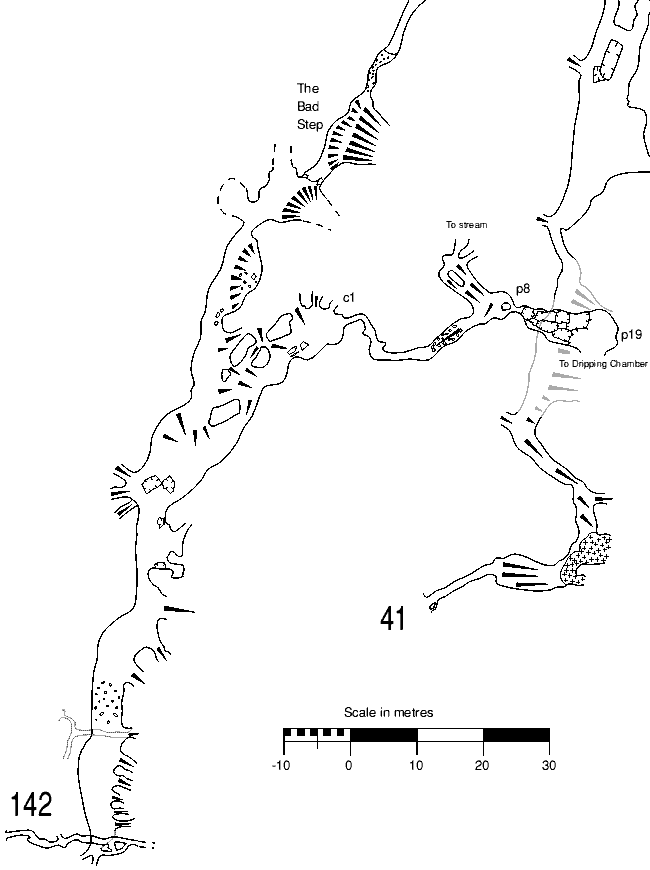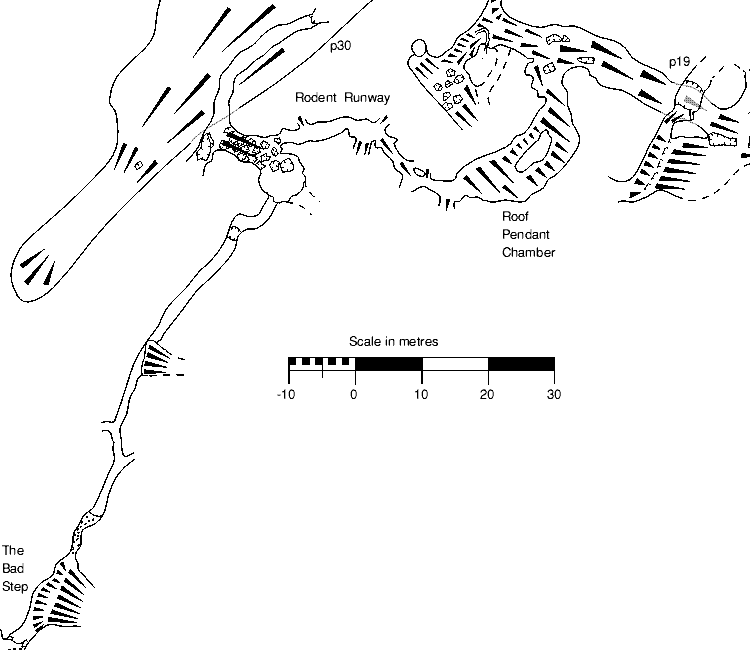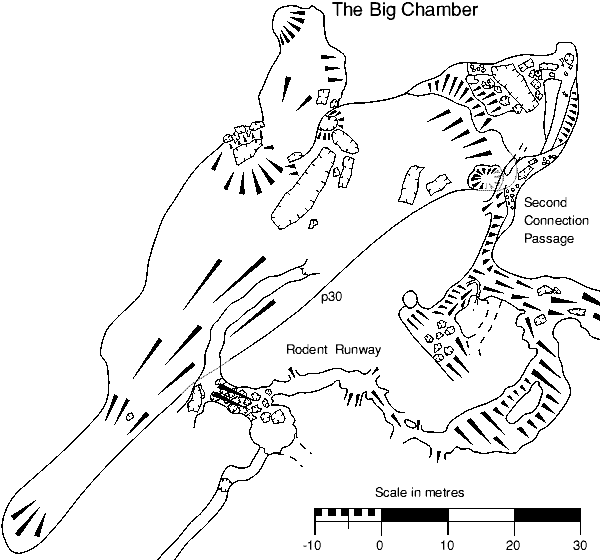
This area comprises the entrance series to 1623/41 and the ramifications of the linked entrance 1623/142, together with an apparently independent way on in 41 itself. The passages are developed in a series of hading rifts of considerable complexity, and only main routes through have been fully surveyed, by two different groups, over a decade apart. Sometimes it is clear where we have both surveyed the same passage, but in other places it is far from obvious. If the description seems confusing, then so is the cave !
The passages are described as seen from three main routes - the way through 142, the main way through 41, and the German route through 41. These routes are roughly parallel, and penetrate the hillside progressively further to the east, or down the dip of the ramps. Some of these ramps remain unexplored but probably connect the three routes in yet more places.
Location: E 35772.8 N (52)81214.6 H 1615.6
This is reached by bashing up an indistinct gully from Windloch (1623/32) on the Stöger Weg until an entrance marked P132 (sic) in red paint is reached. Initially thought to be a possible higher entrance to the system, it is actually a little lower than Stellerweghöhle itself.
A small tube at the entrance quickly leads to a short drop and spiral round into the start of a hading rift, much like Stellerweg on a smaller scale. Down the first ramp on the right is "Wiggy's way to 60' pitch" [C1982-142-19], while straight on leads for 15m to where a trench intersects the floor. Down this to the left leads to a pitch [C1982-142-20]. The main way continues low past holes in the floor [C1982-142-21] on the right, then over a rock into a small chamber with a cairn.

To the left up a slope is the main way, but various gaps on the right lead through a low section downhill [C1982-142-22]. To the left after 10m, a crawl up leads to a ramp back to the main route, while up a 1m step to the right, a crawl leads under a low arch and continues to intersect a ramp [C1983-142-02]. Up to the left leads to the noise of a stream [C1983-142-03], with a further QM [C1983-142-04] to the right of it, undescribed but shown on the survey. Down to the right reaches an 8m pitch landing on jammed boulders, followed by a 19m pitch in a dripping chamber. Arge's survey suggests that across this pitch (traverse on left) leads in a few metres to the main way in 41. An unexplored passage [C1983-142-05] leads south towards the entrance - this appears to choke very close to the main 41 passage on the Arge survey. The dripping chamber is area is very close to Stellerweg, but below the main route.
The main route from the chamber (with the cairn) goes uphill to a low section, then keeps left round a choked depression in the floor of a chamber. The way narrows below a tight lead on the left [C1982-142-23], then enlarges at another ramp. Up and left is a way up to a tight rift [C1982-142-24]. Both of these ways up left seem to connect into Schwabenschacht, while down the ramp is unexplored but probably leads back down to the dripping chamber [C1982-142-25]. Another constriction leads to a "bad step" over a ramp to the right [C1982-142-26], but none of the ramps are as awkward to cross as the lined traverses in Stellerweg.

A longer crawl continues, passing small holes to right [C1982-142-27] and then left [C1982-142-28], before a step down above another ramp to the right [C1982-142-29]. Straight on is a rift leading over a hole in the floor [C1982-142-30], finally to emerge at the bottom of a small boulder chamber Vereinigungshalle sloping up to the left. At the top is a T-junction, left [C1982-142-31] was soon blocked by a large boulder, which was passed by a short dig from the far side, to provide the first connection from Schwabenschacht (1623/78). To the right at the T-junction leads on until, after 20m, the floor drops away into blackness [C1982-142-32], which proved to be a 32m pitch into the Big Chamber.

 The
imaginatively named Big Chamber is by far the largest chamber in the
Stellerweg part of the system, 90m long, 30m wide,
and 40m from the roof at the pitch to the lowest point of the floor. This is
at the South West end of the SW-NE aligned chamber, while at the other end,
the floor rises over boulders towards the arched roof. An extension to the
north at this end leads to a depression in the floor. The north side of the
chamber generally ends too low where the boulder floor meets the roof. A way
up at the NE end of the chamber
[C1982-142-34] has
now been connected into Stellerweg. Descents into
boulders
[C1982-142-33] are
possible at various points, but progress seems unlikely. Having said that,
Arge seem to have pushed an extension hereabouts to find
Richie-Meander.
The
imaginatively named Big Chamber is by far the largest chamber in the
Stellerweg part of the system, 90m long, 30m wide,
and 40m from the roof at the pitch to the lowest point of the floor. This is
at the South West end of the SW-NE aligned chamber, while at the other end,
the floor rises over boulders towards the arched roof. An extension to the
north at this end leads to a depression in the floor. The north side of the
chamber generally ends too low where the boulder floor meets the roof. A way
up at the NE end of the chamber
[C1982-142-34] has
now been connected into Stellerweg. Descents into
boulders
[C1982-142-33] are
possible at various points, but progress seems unlikely. Having said that,
Arge seem to have pushed an extension hereabouts to find
Richie-Meander.
From halfway up Vereinigungshalle before the pitch into the Big Chamber, an obscure route through boulders [C1983-142-00] leads down to the head of a ramp. This passage is Rodent Runway, after some remains of dubious taxonomy. Sketches show up to seven ways on [C1983-142-01] off Rodent Runway. The route swings left across the strike of the ramp in Roof Pendant Chamber, before intersecting another, bigger ramp. Up eventually leads back to the Big Chamber at [C1982-142-34], while down leads to Megalo-Schlinger at the foot of the 21m pitch in Stellerweg, emerging from [C1980-41-17].
The main route explored by CUCC in 1980 pursues a determined course into the hill, passing numerous ramps and side passages, almost all of which were left for subsequent explorers. The initial passage to the left just inside the entrance crosses a ramp [C1980-41-01] by a traverse (over ice in 1980) and leads up a ramp until this becomes lower (but continues as [C1980-41-02]) and a way opens across the strike to the right. The route across this immediately intersects a large 45° ramp [C1980-41-03]. This is traversed over and a small uphill passage [C1980-41-04] is passed on the left. Three more descending ramps [C1980-41-05, C1980-41-07, C1980-41-11] are crossed in a short distance, with a small downhill passage after the second of these [C1980-41-08]. A number of small unpushed passages lead off left [C1980-41-06, C1980-41-09, C1980-41-10, C1980-41-12].
The final ramp is the main way on, while across it leads to the original route at the head of a 21m pitch. A possible passage [C1980-41-15] over the pitch would require a bolted traverse, but would almost certainly merely connect into Doppelbodenhalle. Below the pitch, a ramp [C1980-41-16] leads down to a chamber Megalo-Schlinger from where many ways lead on. These have since been looked at by Arge.
A joint plane [C1980-41-18] down dip is obstructed by boulders and a climb down [C1980-41-19] leads via a squeeze into a very small vadose canyon. These both appear to lead into Warme Duscher Rampe, a passage which appears to end wide but inconclusive on the Arge 1998 survey.
A ramp up [C1980-41-17] under the old 21m pitch leads to the two connections to 142, one left to Roof Pendant Chamber and the other straight on to emerge at C1982-142-34 in the Big Chamber.
A second ramp [C1980-41-20] up NE then NW is Doppelbodenhalle, which emerges at Quickie-Rampe, which appears complex at the point of entry. It descends steeply to the right (ESE) and ends about 20m below the post-1981 route to the Big Pitch, heading in the same direction. It seems likely to lead to another way into the same shaft, possibly with a shorter hang.
Down a ramp to the right at the start of Doppelbodenhalle goes to a right turn, [C1980-41-22] and seems to be an easier way into BUS than the way used by CUCC in the 1980s, but the CUCC and Arge surveys don't seem to correlate well hereabouts.
The main route is a climb up a narrower ramp left off the start of Warme Duscher Rampe. This brings one shortly into BUS, a steeply descending phreatic passage and climbs which are followed by lined traverses across two ramps [C1980-41-23, C1980-41-24]. These are both very steep and slippery, and would require rigging, especially in view of the fact that they head towards the vicinity of the 100m Big Pitch.
It should be noted that some of these leads have since been pushed by Arge, and rejoice in names such as Manhattan and Fritz's Freeway. This description is thus somewhat out of date and rather remedial in that attempts have been made to indicate the new passages by building description from a survey on which many of the passages are not explicitly named, and survey data commented in a language foreign to the writer...
Various routes converge on the Big Pitch, but either of two up-ramps, above the pitch heads, lead to a small junction chamber, where a steep slope up on the left [C1980-41-26] leads back to the ramp used to gain access. Other ways [C1980-41-27, C1980-41-28] from this ramp remain inadequately described, but are probably the passage explored by Arge, Alice im Wunderland, which trends north, then NE for 100m, changing name to blödes Eck and ending at an unexplored pitch, which seems 99% certain to drop into the Yellow Brick Road in 1623/144, probably about a p20m.
Straight on from the above junction chamber, a small passage leads after 20m to a small inlet on the left, also unexplored [C1980-41-29]. The water from this falls into a deep canyon below the passage ahead. A descending traverse leads after 30m to the foot of an aven [C1982-41-38] from where hammering at the bottom of a nearby pothole (entrance numbered 143, 140m deep) can be clearly heard, though a voice connection could not be achieved. The top of the aven is about 15m below the end of 143, and perhaps 20m away horizontally. The connection would add no new depth to the system.
From the snowbank in the entrance chamber, a narrow ramp down to the east, Extrablatt, curves round left to meet a larger ramp coming down. This ramp also comes from the entrance chamber, by a right turn from he north exit. Continuing north from the junction, two more ramps from above also come from the passage to the north of the entrance chamber. The CUCC sketch notes a couple of ramps downwards too. The main way is a roped traverse over a choked pot [X0000-41-03] (reported to be 28m deep, though not descended by CUCC). Heading north from this point, then keeping left, an ascending ramp is DIN-Rampe, connecting back to the main route not far before Megalo-Schlinger.
Shortly beyond the choked 28m pitch (and presumably one of the unsurveyed ways to the right on the Arge survey) is the head of a series of pitches [X0000-41-04], best rigged from the far end of a further traverse. This series came to be known as Stalaglufthöhle. The pitches were originally reported to be 220m deep by the German explorers. Although the shafts descended by CUCC are pretty much where we were led to believe the German big shaft lay, there is a niggling suspicion that the Germans had in fact found a route [C1980-41-39] from here to the Big Pitch, which would be a much more convincing fit to the description we have.
The first two drops are 6m and 18m to the floor of a rift. At one end of this is a 20m pitch with a small outlet at its base (not explored) [C1980-41-43], but in the other direction pitches of 2, 12 and 14m lead to an awkward traverse above a canyon. The route turns left (straight on has not been pushed [C1980-41-40]) and soon drops down a 10m free climb to a low crawl which looks like a dried out sump. Beyond this, the crawl continues unexplored [C1980-41-41] but through a window to the right, a climb down and traverse (over an unexplored hole [C1980-41-42]) leads to a 14m pitch (sloping at the top) which lands in a chamber. Pitches of 8, 12 and 6m follow in a rift until the route narrows at the head of a pitch (estimated 6m) which has not been descended [C1980-41-44].
The route as described had survey cotton for some way, but there was no sign of previous exploration at the end.
From the lower part of the 100m pitch, a rift window is visible in the opposite direction from the way on below. This rift pitch [C1980-41-32] marks the entry from Lärchenschacht (1623/88).
Unfortunately, the group that explored this cave, whilst being very keen to hear from CUCC about our finds in the early eighties, were reluctant to reveal anything of value about their explorations (which were not then complete), so we have no written description from them. However, recent improvements in dialogue mean that we have a survey of the cave, from which a description has been built. The further ramifications of this cave connect through to the Schwarzmooskogeleishöhle (1623/40) with a further 2.5km or more of passage.
Downstream in Wet 'n' Wild, about 10m from the Big Pitch, a climb up to a passage on the left [C1980-41-34] remains unexplored (and was not mentioned in the published description). Downstream about 20m from the pitch, a chimney in the right wall [C1980-41-33] marks the entry of the route from CUCC's highest entrance, 144. The continuation of the rift can be followed in a sharp passage until the stream disappears into a hole [C1980-41-35], apparently reputed to be a sump, but in fact, no attempt to follow it has been formally recorded, so this may be in error.
Above the hole, in the main way on after 90m (before regaining the water), a large (2.5m+ diameter?) unexplored passage [C1980-41-36] with no obvious draught comes in from the right. This may be the passage shown on the Arge survey as turning right after 10m or so, then ending a similar distance beyond.
After the 20m pitch, the 9, 5, 6 and 6m pitches are increasingly tight, and it is thought likely that a much larger continuation could be found by a (possibly heroic) traverse or pendulum from the vicinity of the 9m pitch - though it has to be said that this QM [C1980-41-37] has not actually been seen.